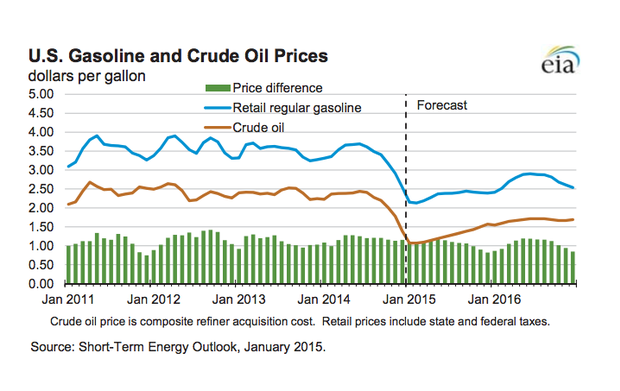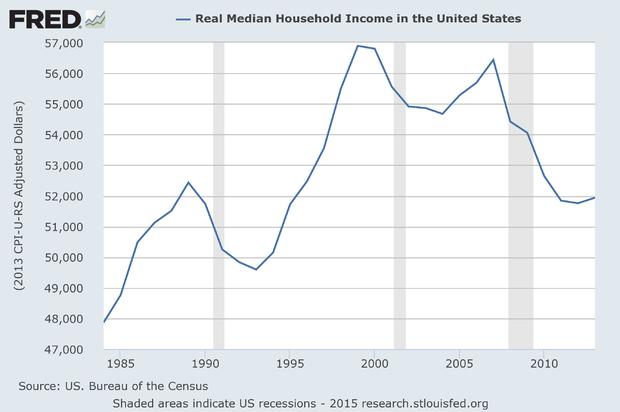Understanding the U.S. economy in 5 charts
President Obama has a lot going in his favor when he speaks to the nation in his annual State of the Union speech Tuesday night.
The job market is rebounding and economic growth is picking up, while the U.S. economy is healthy compared much of the rest of the world. Consumer polls show that Americans' spirits are reviving as prices at the pump have plunged.
In his address, Mr. Obama will no doubt trumpet the progress the country has made since the calamitous housing crash. But the U.S. economic picture is, while improving, far from rosy. The recovery hasn't reinvigorated every corner of the economy, with millions of Americans still unemployed or too discouraged to look for work, wages yet to grow in earnest and roughly 20 percent of children living in poverty.
Click ahead for five charts that help explain what's still holding back the economy and what needs to change if it is to flourish in 2015.
Tumbling gas prices
Remember those early days of 2011, when gas was heading toward $4 a gallon? The price of fuel has plunged by more than 50 percent since then, due largely to a glut of supply and slumping worldwide demand.
That's just fine with American drivers, who this week have been enjoying prices of $2.06 a gallon on average. That's down from $2.13 a week ago and $2.45 a month ago, according to AAA's Fuel Gauge report.
Cheap gas could give U.S. drivers about $700 in extra cash this year, analysts say. Although that may not seem like a huge sum on an individual basis, for the economy as a whole that represents an economic boost that many never saw coming.
Growing income inequality
It's no secret that the rich are getting richer. On a global level, the wealthiest 1 percent are projected to control more than half the world's wealth by next year, according to anti-poverty charity Oxfam.
The gap between rich and poor is widening within the U.S. as well. Fifty years ago, the top 1 percent in the U.S. only had about 8 percent of overall income, according to the University of Paris' World Top Incomes database. But that began to change in the late 1970s, with the trend really starting to accelerate in the late '80s, when the top earners' income share reached 13 percent.
Fast forward to 2010, and the top 1 percent are taking home more than 17 percent of the nation's income. It got even worse in 2012 (the last year for which the data is available) -- even as the recovery was supposed to be lifting the entire economy -- when the share rose to 19.3 percent.
Mr. Obama is expected to address income inequality with his proposal to hike capital gains taxes on wealthy Americans and to slap new fees on large financial firms.
Solid job growth
The economy added nearly 3 million jobs in 2014, creating labor at all wage levels across a range of industries. Small businesses, which account for a lion's share of job-creation, have also started to hire again, although cautiously so. Stronger job growth has brought the unemployment rate down to 5.6 percent, and experts think the job market will continue to heal in 2015.
Some Americans are not in the jobs they want or need, however, with millions of Americans stuck in low-paying jobs and many others out of the labor market altogether. As of December, the U.S. still had a labor gap -- the number of jobs the economy needs to create to return to the employment levels that prevailed before the Great Recession -- of 4.6 million. At the current rate of job growth, it would still take another two years to close that gap.
Slow wage growth
Check out how strongly American productivity has grown since the 1950s. Companies in the U.S. are hugely efficient and productive, for the most part. But workers aren't seeing the financial benefits of those well-run operations.
It wasn't always this way. From 1948 to 1979, worker compensation rose some 93 percent -- a respectable gain considering that net productivity in the country rose 108 percent at the same time, according to the Economic Policy Institute.
But something happened starting in the 1980s. Productivity kept going, but worker pay hit the wall. From 1979 to 2013, worker pay only rose 8 percent, while productivity rose 65 percent. Productivity has also slowed of late, raising concerns about longer term economic stagnation.
Falling household income
American households earn less now than they did 15 years ago. Median household income, adjusted for inflation, was just under $52,000 in 2013, according to the U.S. Census Bureau. That's down from a peak of $56,800 in 2000.
Mr. Obama -- along with the Federal Reserve, which has sought to stimulate growth by holding down interest rates -- can claim some credit for helping restore the economy. But probably won't touch on how Americans have gone backwards since the 2008 financial crisis. Income at last count is lower than the $54,049 it was at during the President's first year in office, data from Sentier Research shows.





